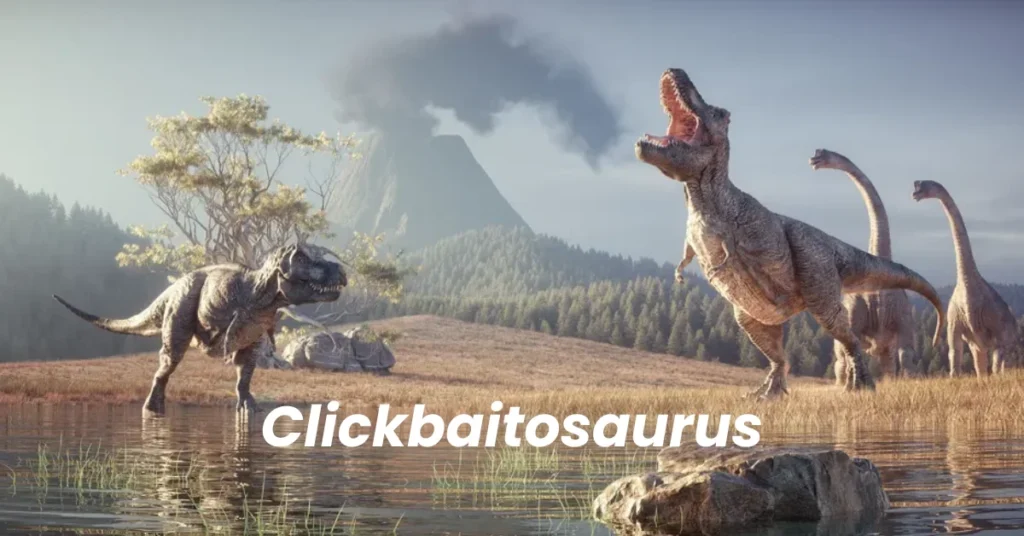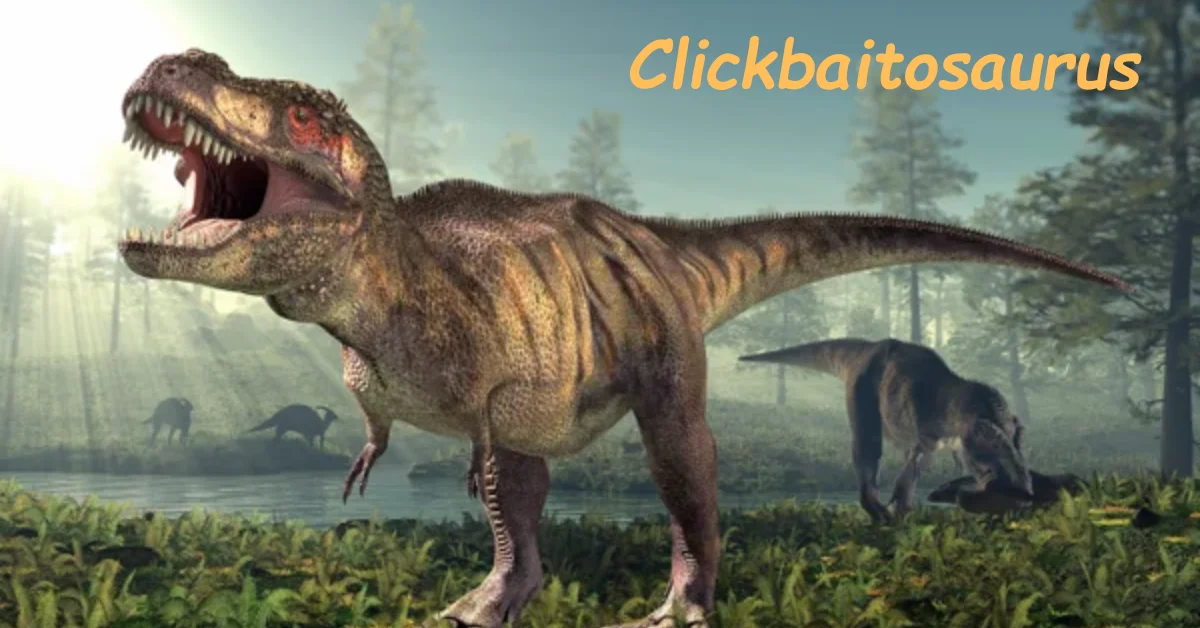Clickbaitosaurus: A Journey Through the Landscape of Online Engagement
In today’s digital age, where the internet is awash with sensational headlines and eye-catching promises, the term Clickbaitosaurus emerges as a metaphor for the pervasive phenomenon of clickbait. This mythical creature thrives in our online environment, preying on curiosity and leading users into a maze of exaggerated claims and misleading content.This comprehensive article delves into the nature of Clickbaitosaurus, exploring its characteristics, impact, and strategies for navigating the digital landscape to avoid falling prey to its tricks.
What is Clickbaitosaurus?

Clickbaitosaurus is an emblematic animal representing the craftsmanship and science behind making content that gets consideration and drives commitment. This includes making titles that provoke interest, inspire feelings, and force clients to click. Be that as it may, there’s something else to it besides gaudy titles — fruitful viral substance should convey genuine worth and resound with the crowd.
From Clickbait to Clickbaitosaurus
The term “Clickbaitosaurus” is a metaphor for the exaggerated and predatory nature of modern clickbait. In today’s fast-paced digital age, grabbing a user’s attention is more competitive than ever, and content creators often feel the pressure to adopt these tactics. As a result, clickbait tactics have grown more elaborate, blending outrageous headlines with emotionally charged language and sensationalized media. Clickbaitosaurus thrives on our curiosity and desire for quick, digestible content.
The Rise of the Clickbaitosaurus
Early Beginnings of Clickbait
Clickbait started as simple, catchy headlines used by websites to draw in curious readers. Initially, these headlines seemed harmless enough, offering interesting content for audiences. However, as competition for attention increased, headlines became more extreme, giving birth to the “Clickbaitosaurus” – the exaggerated form of clickbait we see today.
Evolution to the Clickbaitosaurus
The shift toward more aggressive clickbait tactics was driven by the rise of social media platforms and the monetization of online content. Platforms like Facebook and Twitter amplified the spread of attention-grabbing headlines, while websites sought ways to maximize their revenue by increasing page views. This encouraged sensationalism, leading to the rise of the “Clickbaitosaurus” — content that prioritizes clicks over substance.
The Anatomy of Clickbaitosaurus

So what exactly does Clickbaitosaurus look like? Here are a few common features that define this modern beast:
1. Sensationalized Headlines
Headlines like “You Won’t Believe What Happened Next!” or “This One Trick Will Change Your Life Forever!” are classic examples of clickbait. Clickbaitosaurus takes it a step further by incorporating current trends, memes, or controversial topics to amplify its reach.
2. Emotional Manipulation
Clickbaitosaurus doesn’t just prey on curiosity; it also exploits emotions. Words like “shocking,” “amazing,” and “heartbreaking” are used to invoke emotional reactions, compelling users to click without thinking critically about the content.
3. Misinformation or Overpromising
While traditional clickbait often left readers disappointed, Clickbaitosaurus can be even more deceptive. It may present information that is either exaggerated or completely false, damaging the trust between the audience and content creators.
4. Multi-Platform Adaptability
Clickbaitosaurus isn’t confined to one type of content. It can appear in blog posts, social media, YouTube thumbnails, and even newsletters. Its ability to adapt across multiple platforms makes it a formidable force in the digital ecosystem.
Read More: Twñcel
The Impact of Clickbaitosaurus on Online Content
The rise of Clickbaitosaurus has had profound consequences for both consumers and creators of online content. While it may seem like a quick way to gain views and engagement, its long-term effects can be damaging.
1. Declining Trust in Media
As consumers become more aware of clickbait tactics, trust in online media has diminished. Many users now view headlines with skepticism, which can hurt legitimate content creators who are striving to provide valuable information.
2. Short Attention Spans
Clickbait thrives in environments where quick consumption is the norm. As a result, it contributes to shortening attention spans, with users less willing to engage in long-form or in-depth content.
3. Algorithm Manipulation
Clickbaitosaurus is often designed to take advantage of platform algorithms. Whether it’s SEO-optimized headlines or trending social media hashtags, it manipulates the system to gain visibility. However, platforms like Google and Facebook are constantly updating their algorithms to reduce the reach of clickbait, meaning content creators who rely on these tactics may see diminishing returns.
4. Harming Genuine Content
Because Clickbaitosaurus content tends to generate more immediate clicks, it can overshadow genuine, well-researched articles. This pushes more informative content into obscurity, reducing its visibility and impact.
How to Avoid Falling for Clickbaitosaurus

As Clickbaitosaurus continues to roam the digital landscape, it’s essential to learn how to avoid falling into its trap. Here are a few strategies:
1. Be Skeptical of Sensational Headlines
If a headline seems too good to be true, it probably is. Take a moment to evaluate whether the content is from a trustworthy source before clicking.
2. Check the Source
Always look at the website or social media account that’s publishing the content. If it’s a reputable platform with a history of delivering accurate information, it’s less likely to be clickbait.
3. Read the Comments
On platforms like YouTube or Facebook, the comments section can often reveal whether a piece of content lives up to its headline. Users frequently call out clickbait in the comments, which can save you from wasting time on low-quality content.
4. Educate Yourself
Understanding how algorithms work and why certain headlines appear in your feed can help you navigate the digital world more wisely. Being informed about how clickbait operates can make it easier to avoid.
Strategies for Taming the Clickbaitosaurus
1.Bring Value to Your Content
While it’s tempting to rely solely on sensationalism, delivering valuable, informative content is key. Ensure that your article, video, or post fulfills the promise made in the headline. This establishes trust and encourages return visits.
2. Be Honest but Entertaining
A balance between entertainment and integrity is essential. Avoid outright deception—misleading content will backfire and damage your credibility. Instead, use clever wording to generate interest while remaining truthful.
3. Utilize Social Media Wisely
Platforms like Facebook, Twitter, and Instagram are playgrounds for the Clickbaitosaurus. Tailor your headlines and visuals for each platform to maximize reach and engagement. Remember, what works on one may not work on another!
4. Test and Analyze
Experiment with different headlines, formats, and styles to see what resonates with your audience. Use analytics to understand what draws clicks and engagement, allowing you to refine your strategy continuously.
The Future of Clickbaitosaurus

While clickbait has evolved into the mighty Clickbaitosaurus, it’s unlikely to disappear anytime soon. However, as platforms continue to refine their algorithms and consumers become more media literate, we may see a decline in its effectiveness. Content creators who prioritize value, honesty, and integrity will likely emerge stronger, leaving Clickbaitosaurus to eventually go extinct.
FACTS
- Origin of the Name: The name combines “clickbait,” referring to content that aims to draw in users with sensational headlines, and “saurus,” a suffix often associated with dinosaurs, implying something large and clumsy.
- Purpose: The main goal of clickbait is to generate traffic to websites, increase ad revenue, and boost engagement, often at the expense of genuine content.
- Common Techniques: Clickbait often uses exaggerated headlines, provocative questions, or teasers that promise shocking revelations or life hacks, without delivering substantial content.
- Criticism: It’s frequently criticized for promoting low-quality journalism and misleading audiences, leading to a cycle of distrust in media.
- Impact on SEO: While clickbait can initially increase clicks, it can harm a site’s long-term SEO if users bounce quickly, as search engines prioritize high-quality, relevant content.
- Evolving Strategies: As audiences become more aware of clickbait tactics, some creators are shifting towards more genuine, value-driven headlines to maintain trust.
FAQs
What is clickbait?
Clickbait refers to sensationalized or misleading content designed to attract clicks. It often features exaggerated headlines and promises more than the content delivers.
Why is clickbait used?
It is used to increase website traffic, generate ad revenue, and boost engagement metrics. Content creators may resort to clickbait to stand out in a crowded digital landscape.
How does clickbait affect content quality?
While clickbait can drive initial clicks, it often results in low-quality content, which can frustrate users and diminish trust in the source.
Are there different types of clickbait?
Yes, common types include listicles, shocking headlines, and ambiguous teasers that suggest outrageous or unexpected information.
How can I recognize clickbait?
Look for headlines that seem overly sensational, vague, or promise something too good to be true. If the title doesn’t match the content, it’s likely clickbait.
Conclusion
In the digital age, clickbaitosaurus represents a fascinating intersection of marketing strategy and audience engagement, illustrating both the potential and pitfalls of sensationalized content. While clickbait can effectively drive traffic and increase visibility, it often compromises content quality and user trust.
Stay Connected & Touch With: Tribuneradar.Com!






